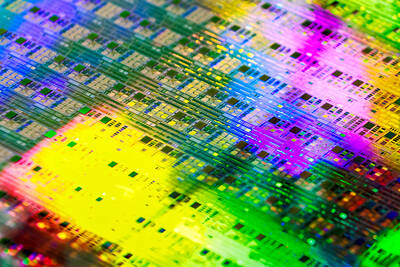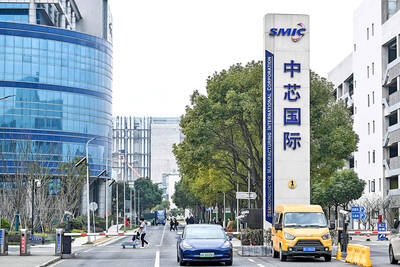The government’s business climate monitor last month turned “yellow-red” from “red,” indicating that Taiwan’s economy continued to expand, although some barometers slowed because of fewer working days, the National Development Council (NDC) said yesterday.
The composite score shed 4 points to 34, but both indices of leading indicators and coincident indicators moved up, affirming steady growth, the council said.
“The slowdown had much to do with the Lunar New Year holiday and the government is closely watching for any shift in economic trend,” NDC Department of Economic Development Deputy Director Chen Mei-chu (陳美菊) told a news conference.

Photo: CNA
The council uses a five-color spectrum to describe the nation’s economic state, with “red” signifying a boom, “green” indicating stable growth and “blue” suggesting sluggishness. A dual-color reading means the economy is shifting gears to a better or worse state.
The yellow-red signal came after exports gained momentum, but manufacturing sales, as well as wholesale and retail revenues, were subdued, the council said.
Tech firms remained busy to meet demand from global customers for electronics used in artificial intelligence (AI), but non-tech firms’ operations slowed in observance of the Lunar New Year after frontloading activity ahead of expectations of tariff hikes subsided, Chen said.
The index of leading indicators, which seeks to project the economic scene in the coming six months, increased 0.32 percent, up for a second straight month, as export orders, imports of semiconductor equipment and manufacturing business confidence displayed positive momentum, the council said.
Companies received more orders for information and communications technology products, as AI applications widened, which is favorable to exports, Chen said.
Likewise, the index of coincident indicators, which reflects the current economic situation, edged up 0.2 percent to 104.28, as industrial production, overtime hours and imports of machinery equipment improved from one month earlier, the council said.
In related developments, Taiwanese grew slightly more confident about spending this month, judging by an uptick of 0.05 points in the consumer confidence index to 72.59, a monthly survey by National Central University (NCU) released yesterday showed.
Specifically, people turn mildly more optimistic about Taiwan’s economic outlook, household income, the job market and purchases of durable goods, noticeably real estate, it found.
The positive-leaning sentiment came despite US President Donald Trump’s threat to impose tariffs on semiconductors, which bodes ill for Taiwanese chipmakers, NCU economics professor Dachrahn Wu (吳大任) said.
However, people expressed concern over the consumer price trend amid fears that the electricity prices might rise later this year after the legislature canceled a budget to aid lossmaking Taiwan Power Co (台電), Wu said.
Electricity price hikes would fuel inflation, he added.

NO BREAKTHROUGH? More substantial ‘deliverables,’ such as tariff reductions, would likely be saved for a meeting between Trump and Xi later this year, a trade expert said China launched two probes targeting the US semiconductor sector on Saturday ahead of talks between the two nations in Spain this week on trade, national security and the ownership of social media platform TikTok. China’s Ministry of Commerce announced an anti-dumping investigation into certain analog integrated circuits (ICs) imported from the US. The investigation is to target some commodity interface ICs and gate driver ICs, which are commonly made by US companies such as Texas Instruments Inc and ON Semiconductor Corp. The ministry also announced an anti-discrimination probe into US measures against China’s chip sector. US measures such as export curbs and tariffs

The US on Friday penalized two Chinese firms that acquired US chipmaking equipment for China’s top chipmaker, Semiconductor Manufacturing International Corp (SMIC, 中芯國際), including them among 32 entities that were added to the US Department of Commerce’s restricted trade list, a US government posting showed. Twenty-three of the 32 are in China. GMC Semiconductor Technology (Wuxi) Co (吉姆西半導體科技) and Jicun Semiconductor Technology (Shanghai) Co (吉存半導體科技) were placed on the list, formally known as the Entity List, for acquiring equipment for SMIC Northern Integrated Circuit Manufacturing (Beijing) Corp (中芯北方積體電路) and Semiconductor Manufacturing International (Beijing) Corp (中芯北京), the US Federal Register posting said. The

India’s ban of online money-based games could drive addicts to unregulated apps and offshore platforms that pose new financial and social risks, fantasy-sports gaming experts say. Indian Prime Minister Narendra Modi’s government banned real-money online games late last month, citing financial losses and addiction, leading to a shutdown of many apps offering paid fantasy cricket, rummy and poker games. “Many will move to offshore platforms, because of the addictive nature — they will find alternate means to get that dopamine hit,” said Viren Hemrajani, a Mumbai-based fantasy cricket analyst. “It [also] leads to fraud and scams, because everything is now

MORTGAGE WORRIES: About 34% of respondents to a survey said they would approach multiple lenders to pay for a home, while 29.2% said they would ask family for help New housing projects in Taiwan’s six special municipalities, as well as Hsinchu city and county, are projected to total NT$710.65 billion (US$23.61 billion) in the upcoming fall sales season, a record 30 percent decrease from a year earlier, as tighter mortgage rules prompt developers to pull back, property listing platform 591.com (591新建案) said yesterday. The number of projects has also fallen to 312, a more than 20 percent decrease year-on-year, underscoring weakening sentiment and momentum amid lingering policy and financing headwinds. New Taipei City and Taoyuan bucked the downturn in project value, while Taipei, Hsinchu city and county, Taichung, Tainan and Kaohsiung